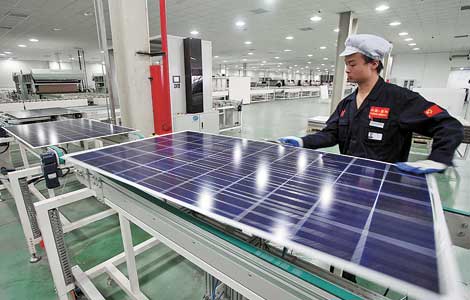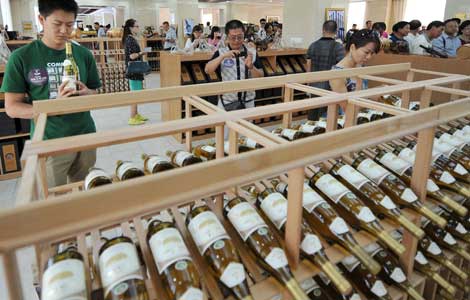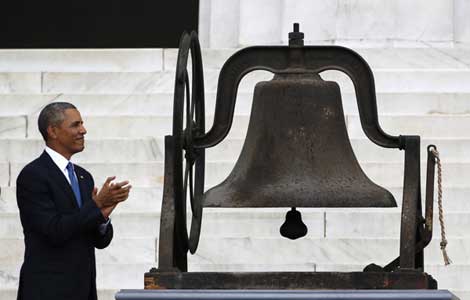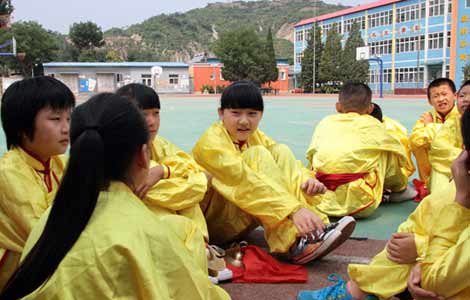Oil giants fail environmental tests
Updated: 2013-08-30 00:30
By Wu Wencong and Shi Jing (China Daily)
|
||||||||
Govt delays approval of CNPC, Sinopec new projects till '13 emissions evaluation
The country's two major oil providers — China National Petroleum Corp and China Petroleum and Chemical Corp — have been punished by the Environmental Protection Ministry for failing their 2012 environmental tests.The evaluation, released on Thursday, was based on four indicators: chemical oxygen demand, which shows the concentration of organic matter in the water; ammonia nitrogen, a major cause of excessive nutrients in water; and the airborne pollutants sulfur dioxide and nitrogen oxide.
The indicator for chemical oxygen demand for China National Petroleum Corp, or CNPC, Asia's largest oil and gas producer, was reduced 0.08 percent in 2012, far below the target reduction of 0.6 percent.
Nitrogen oxide emissions by China Petroleum and Chemical Corp, or Sinopec, in 2012 were originally set at zero growth, but the company increased emissions by 1.28 percent.
Local governments of 31 provinces, municipalities and autonomous regions, and eight State-owned companies were subject to the evaluation.
The two petrochemical giants were the only two that failed, the second consecutive year they failed to reach the bar.
The evaluation found that China succeeded in bringing down overall emissions' chemical oxygen demand in 2012 by 3.05 percent, ammonia nitrogen by 2.62 percent, sulfur dioxide by 4.52 percent and nitrogen oxide by 2.77 percent.
Though a detailed assessment method was not used in 2011, officials from the ministry warned CNPC and Sinopec to take more effective action to curb emissions.
This year, the ministry withheld approval of environmental impact assessment reports for all new modification and expansion projects by the two companies, except for those upgrading oil quality and energy saving.
"When the approval limits will come to an end is still pending," said Huang Xiaozeng, deputy head of the Environmental Protection Ministry's pollution emission control department.
"The time will be based on the two companies' emission reduction evaluations for the first half of 2013," said Huang.
He said the punishment will not affect China's current oil provisions or refining capacity of almost 600 million metric tons per year, not to mention projects outside the refining industry.
The central government required CNPC and Sinopec to reduce their nitrogen oxide emissions by 8 percent, compared with 2005 levels, by the end of 2015. Instead, such emissions increased 8.27 percent for CNPC and 2.52 percent for Sinopec by the end of 2012, according to the ministry.
Sinopec spokesman Lyu Dapeng said that most of its affiliated companies have taken effective action as planned but a few of them, like Sinopec Luoyang Co, Shanghai Co and Anqing Co, did not perform well and affected the overall results.
He said it is Sinopec's social responsibility to reduce emissions and achieve their targets.
He emphasized it recently launched an environmental campaign and will invest 22.87 billion yuan ($3.74 billion) in three years on 803 environmental management projects.
CNPC said the company has earmarked 12.7 billion yuan for pollution reduction projects before 2015 and will implement tougher evaluation measures for affiliated companies, China National Radio reported on Thursday.
Poor facilities
The ministry says all kinds of detailed problems in the two petrochemical companies were found during the investigation process.
The first is the lack of desulfurization and denitrification facilities. One-third of CNPC's 115 coal-burning boilers are not equipped with desulfurization facilities and none are equipped with denitrification facilities.
The situation is no better for Sinopec. About 40 percent of its 174 boilers don't have desulfurization facilities, and only four of them have denitrification facilities.
Investigation also found that the two companies' pollution treatment techniques are ineffective.
Of CNPC's 77 boilers with desulfurization facilities, only 11 of them have a desulfurization efficiency higher than 90 percent, the rate for the others is below 70 percent.
Problems were also found at many of the two petrochemical giants' subsidiary companies, including discharging excessive sewage, affecting the storm-water drainage system with wastewater, and even providing fake online-monitoring data.
The environmental performance of their affiliated companies abroad are leading the world, but their emission reduction efforts within China are far from satisfactory, People's Daily commented on Thursday.
Almost half of the two oil giants' refining capability is located around the cities of Beijing and Tianjin, the provinces of Hebei and Shandong, and the Yangtze River and Pearl River deltas, where airborne pollution is most severe and complex. Yet their affiliated companies are still implementing an outdated atmospheric pollutant standard issued 17 years ago, People's Daily reported.

 Solar panel maker hits milestone
Solar panel maker hits milestone
 Vineyards pour billions into chateaus
Vineyards pour billions into chateaus
 Fair brings Hami melons to Beijing
Fair brings Hami melons to Beijing
 Court sentences 56 for telecom scam
Court sentences 56 for telecom scam
 Foreigners given opportunities to shine
Foreigners given opportunities to shine
 US vows action in Syria even without UN backing
US vows action in Syria even without UN backing
 Li Na advances to 3rd round
Li Na advances to 3rd round
 Obama, marchers mark 50 yrs since King's speech
Obama, marchers mark 50 yrs since King's speech
Most Viewed
Editor's Picks

|

|

|

|

|

|
Today's Top News
UK parliament rejects Syria strike
Visa issues resolved in new policy
Solar panel maker hits milestone
Xi calls for innovation push
Tougher environment takes toll on bank results
Vineyards pour billions into chateaus
Oil giants fail environmental tests
More carriers likely in China
US Weekly

|

|






